Johnson R.S. A Modern Introduction to the Mathematical Theory of Water Waves
Подождите немного. Документ загружается.

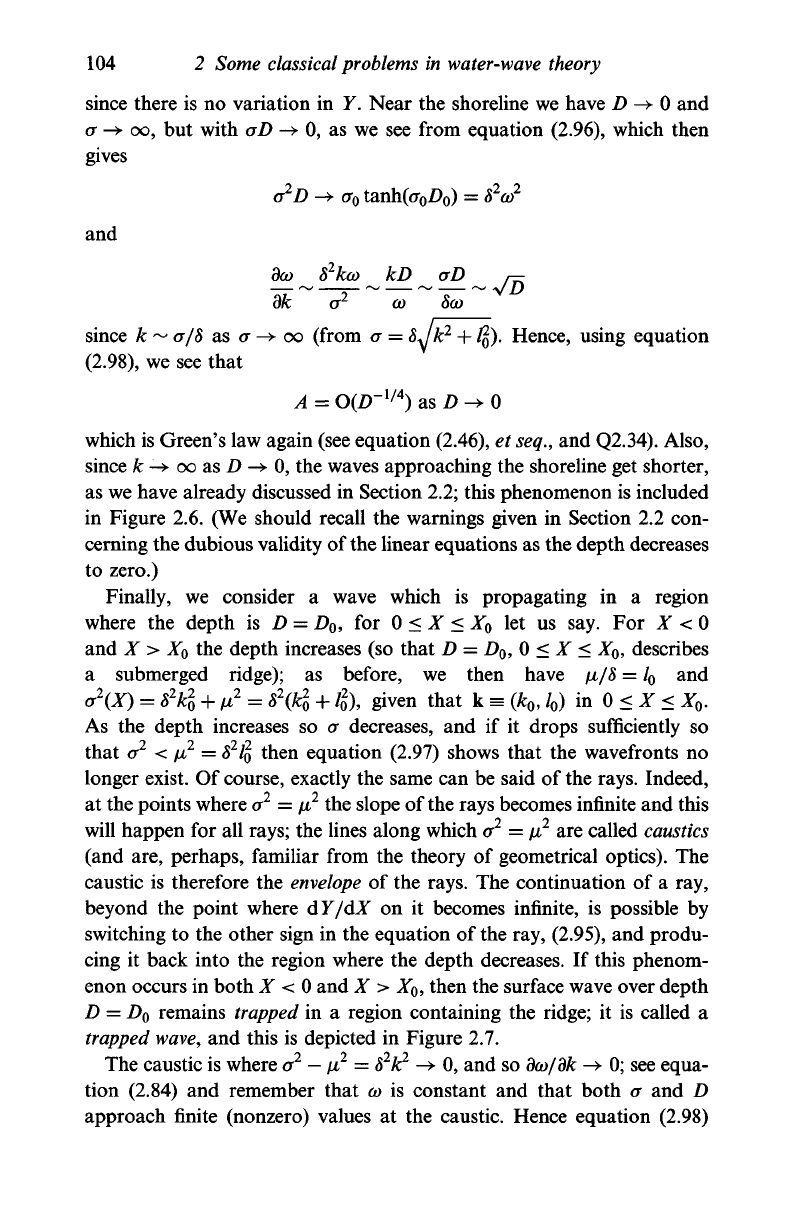
104 2 Some classical problems in water-wave theory
since there is no variation in Y. Near the shoreline we have D -> 0 and
a -> oo, but with oD -> 0, as we see from equation (2.96), which then
gives
= 8
2
co
2
and
dco
^ 8
2
kco ^kD ^oD
dk a
2
(o 8co
since k ~ a/8 as a -> oo (from or = <5 JA;
2
+
/Q).
Hence, using equation
(2.98),
we see that
A = O(ZT
1/4
) as D -* 0
which is Green's law again (see equation (2.46), et seq., and Q2.34). Also,
since k -> oo as
Z>
-> 0, the waves approaching the shoreline get shorter,
as we have already discussed in Section 2.2; this phenomenon is included
in Figure 2.6. (We should recall the warnings given in Section 2.2 con-
cerning the dubious validity of the linear equations as the depth decreases
to zero.)
Finally, we consider a wave which is propagating in a region
where the depth is D = D
o
, for 0 < X < X
o
let us say. For X < 0
and X > X
o
the depth increases (so that D = D
o
, 0 < X < X
o
, describes
a submerged ridge); as before, we then have
/JL/8
= /
0
and
cP-iX) =
8
2
k
2
0
+ fi
2
=
8
2
(k
2
0
+ ig), given that k = (fc
0
, /
0
) in 0 < X < X
o
.
As the depth increases so a decreases, and if it drops sufficiently so
that a
2
< /x
2
=
8
2
IQ
then equation (2.97) shows that the wavefronts no
longer exist. Of course, exactly the same can be said of the rays. Indeed,
at the points where a
2
=
/JL
2
the slope of the rays becomes infinite and this
will happen for all rays; the lines along which a
2
=
/JL
2
are called caustics
(and are, perhaps, familiar from the theory of geometrical optics). The
caustic is therefore the envelope of the rays. The continuation of a ray,
beyond the point where &Y/&X on it becomes infinite, is possible by
switching to the other sign in the equation of the ray, (2.95), and produ-
cing it back into the region where the depth decreases. If this phenom-
enon occurs in both X < 0 and X > X
o
, then the surface wave over depth
D = D
o
remains trapped in a region containing the ridge; it is called a
trapped wave, and this is depicted in Figure 2.7.
The caustic is where a
2
—
/JL
2
=
8
2
h?'
-> 0, and so dco/dk -> 0; see equa-
tion (2.84) and remember that co is constant and that both a and D
approach finite (nonzero) values at the caustic. Hence equation (2.98)
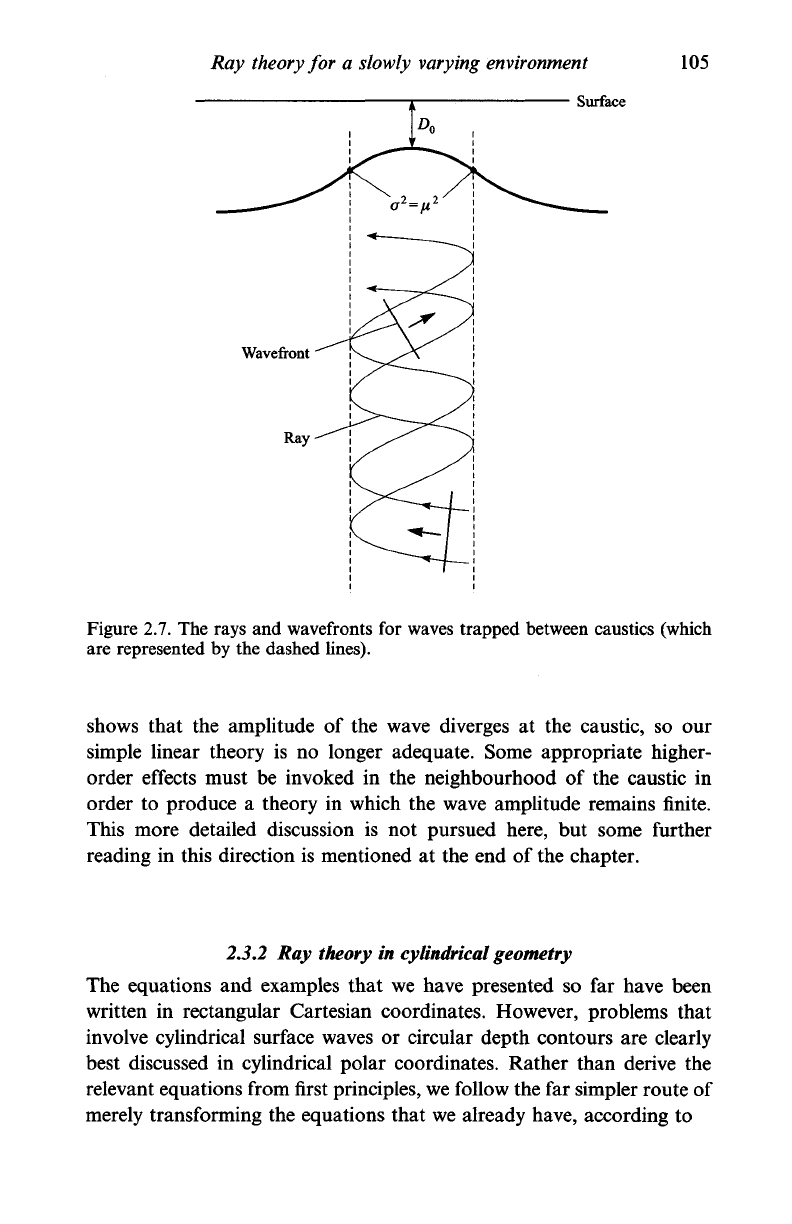
Ray theory for a slowly varying environment 105
Surface
Figure 2.7. The rays and wavefronts for waves trapped between caustics (which
are represented by the dashed lines).
shows that the amplitude of the wave diverges at the caustic, so our
simple linear theory is no longer adequate. Some appropriate higher-
order effects must be invoked in the neighbourhood of the caustic in
order to produce a theory in which the wave amplitude remains finite.
This more detailed discussion is not pursued here, but some further
reading in this direction is mentioned at the end of the chapter.
2.3.2 Ray theory in cylindrical geometry
The equations and examples that we have presented so far have been
written in rectangular Cartesian coordinates. However, problems that
involve cylindrical surface waves or circular depth contours are clearly
best discussed in cylindrical polar coordinates. Rather than derive the
relevant equations from first principles, we follow the far simpler route of
merely transforming the equations that we already have, according to
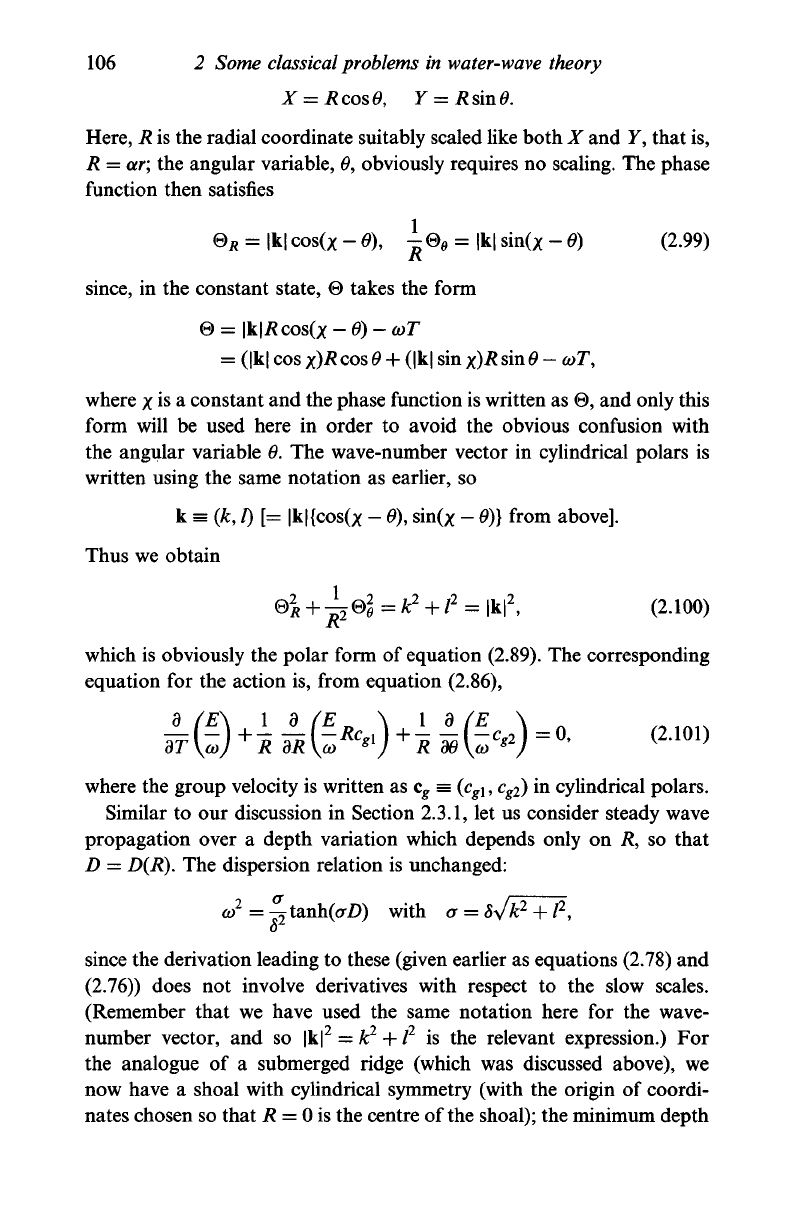
106
2
Some
classical problems
in water-wave theory
X = RcosO,
Y
= RsinO.
Here, R is the radial coordinate suitably scaled like both
X
and F, that is,
R =
ccr;
the angular variable, 0, obviously requires no scaling. The phase
function then satisfies
®
R
=
|k| cos(
X
-
0),
j
0,
=
|k| sin(x
-
0) (2.99)
since,
in
the constant state,
0
takes the form
0 =
\k\Rcos(x-0)-coT
= (|k| cos
x)i*
cos 0
+
(|k| sin x)R sin 6
-
coT,
where
/
is a constant and the phase function is written as 0, and only this
form will
be
used here
in
order
to
avoid
the
obvious confusion with
the angular variable 0. The wave-number vector
in
cylindrical polars
is
written using the same notation as earlier,
so
k
=
(k,
0 [=
|k|{cos(x
-
0),
sin(x
-
0)}
from above].
Thus we obtain
which is obviously the polar form of equation (2.89). The corresponding
equation for the action is, from equation (2.86),
where the group velocity is written as c
g
=
{c
gX
,
c
g2
) in cylindrical polars.
Similar to our discussion in Section
2.3.1,
let us consider steady wave
propagation over
a
depth variation which depends only
on R, so
that
D = D(R). The dispersion relation is unchanged:
co
2
=
-^
tanh(orD) with
a
=
8y/k
2
+
/
2
,
since the derivation leading to these (given earlier as equations (2.78) and
(2.76)) does
not
involve derivatives with respect
to the
slow scales.
(Remember that we have used
the
same notation here
for
the wave-
number vector,
and so
|k|
2
=
k
1
+1
2
is the
relevant expression.)
For
the analogue
of a
submerged ridge (which was discussed above),
we
now have
a
shoal with cylindrical symmetry (with the origin of coordi-
nates chosen so that
JR
=
0 is the centre of the shoal); the minimum depth
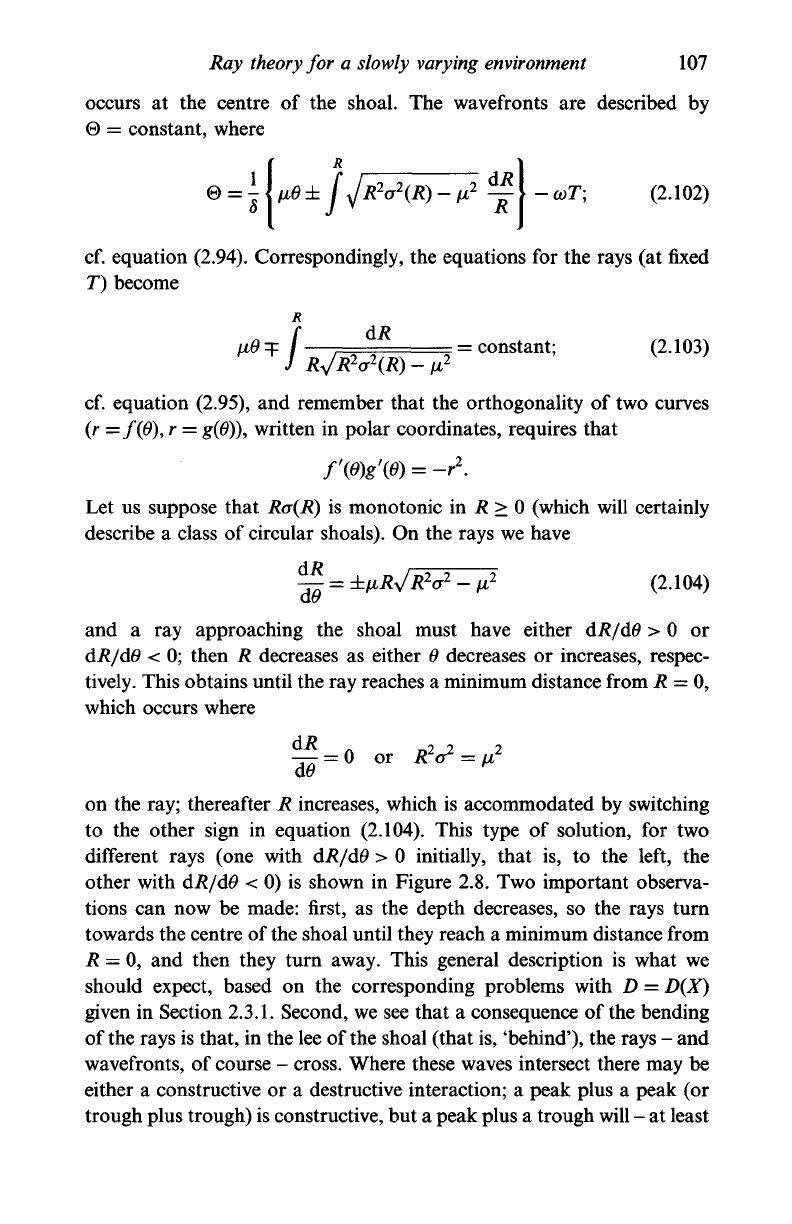
Ray
theory
for
a
slowly varying
environment
107
occurs
at the
centre
of the
shoal.
The
wavefronts
are
described
by
0
=
constant, where
(2.102)
cf. equation (2.94). Correspondingly, the equations
for
the rays
(at
fixed
T) become
dR
=
constant; (2.103)
cf. equation (2.95),
and
remember that
the
orthogonality
of
two curves
(r =f(0),
r
=
g(0)),
written
in
polar coordinates, requires that
f\e)g\e)
=
-?.
Let
us
suppose that Ra(R)
is
monotonic
in R
>
0
(which will certainly
describe
a
class
of
circular shoals).
On the
rays we have
^
= ±fiRy/R
2
a
2
-n
2
(2.104)
and
a ray
approaching
the
shoal must have either dR/dO
> 0 or
dR/dO
<
0; then
R
decreases
as
either
0
decreases
or
increases, respec-
tively. This obtains until the ray reaches
a
minimum distance from
R = 0,
which occurs where
£-0
or
«V-»»
on the ray; thereafter
R
increases, which
is
accommodated
by
switching
to
the
other sign
in
equation (2.104). This type
of
solution,
for two
different rays
(one
with dR/dO >
0
initially, that
is, to the
left,
the
other with dR/dO
< 0) is
shown
in
Figure 2.8. Two important observa-
tions
can now be
made: first,
as the
depth decreases,
so the
rays turn
towards the centre of the shoal until they reach
a
minimum distance from
R
=
0,
and
then they turn away. This general description
is
what
we
should expect, based
on the
corresponding problems with
D =
D(X)
given
in
Section
2.3.1.
Second, we see that
a
consequence
of
the bending
of the rays is that,
in
the lee
of
the shoal (that is, 'behind'), the rays
-
and
wavefronts,
of
course
-
cross. Where these waves intersect there may
be
either
a
constructive
or a
destructive interaction;
a
peak plus
a
peak
(or
trough plus trough) is constructive, but
a
peak plus
a
trough will
-
at least
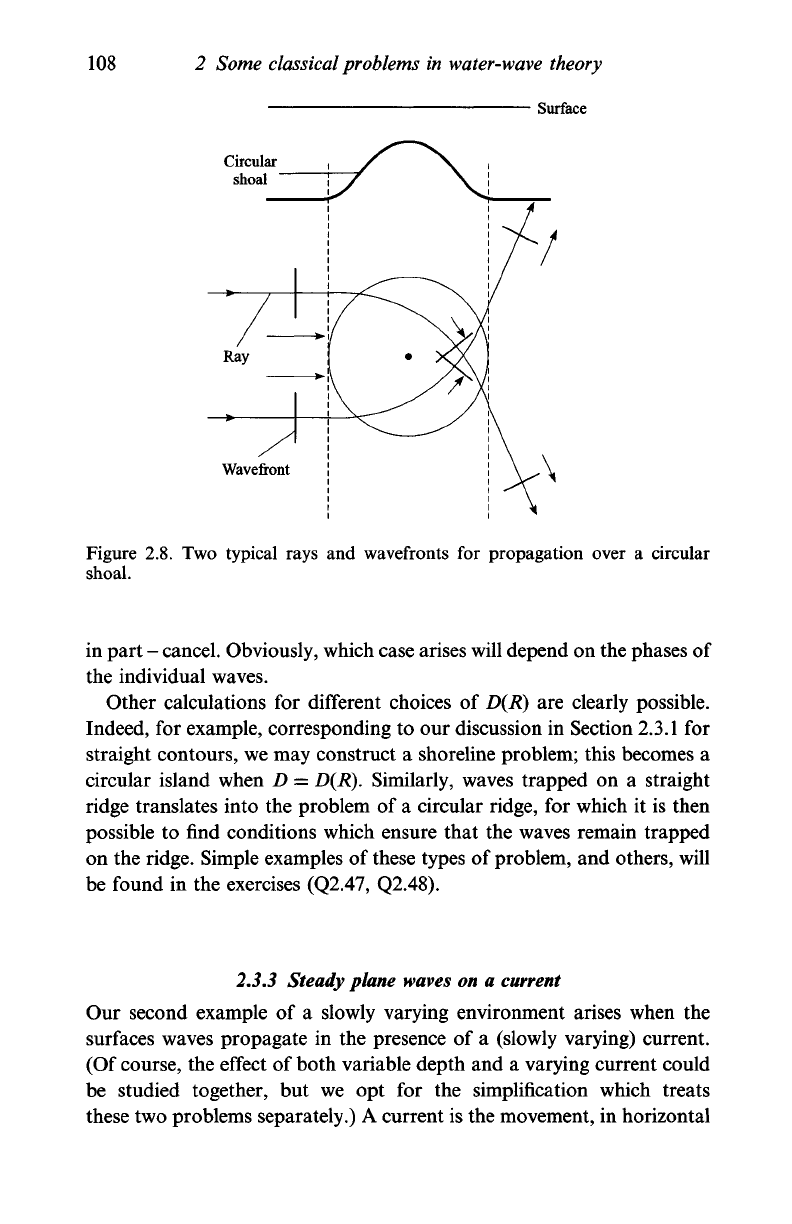
108 2 Some classical problems in water-wave theory
Surface
Circular
shoal
Wavefront
\
Figure 2.8. Two typical rays and wavefronts for propagation over a circular
shoal.
in part - cancel. Obviously, which case arises will depend on the phases of
the individual waves.
Other calculations for different choices of D(R) are clearly possible.
Indeed, for example, corresponding to our discussion in Section 2.3.1 for
straight contours, we may construct a shoreline problem; this becomes a
circular island when D = D(R). Similarly, waves trapped on a straight
ridge translates into the problem of a circular ridge, for which it is then
possible to find conditions which ensure that the waves remain trapped
on the ridge. Simple examples of these types of problem, and others, will
be found in the exercises (Q2.47, Q2.48).
2.3.3 Steady plane waves on a current
Our second example of a slowly varying environment arises when the
surfaces waves propagate in the presence of a (slowly varying) current.
(Of course, the effect of both variable depth and a varying current could
be studied together, but we opt for the simplification which treats
these two problems separately.) A current is the movement, in horizontal
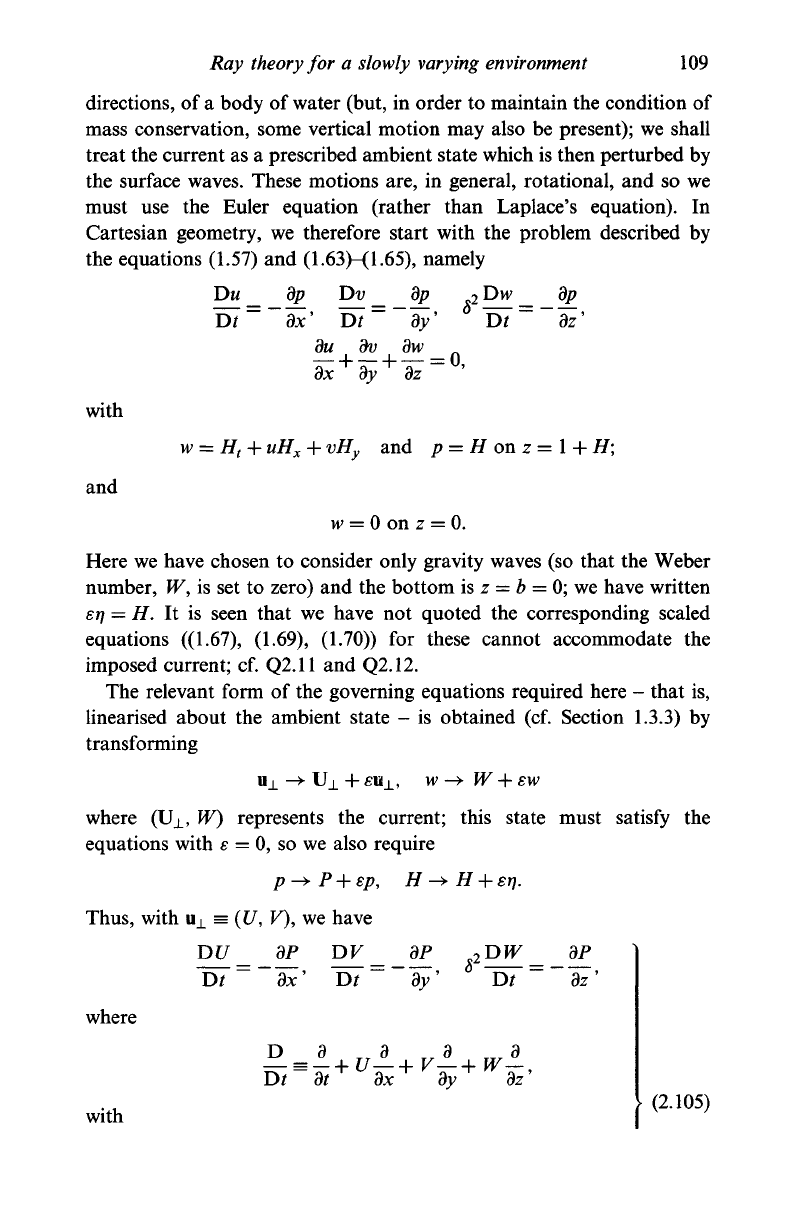
Ray theory for a
slowly varying environment
109
directions, of a body of water (but, in order to maintain the condition of
mass conservation, some vertical motion may also be present); we shall
treat the current as a prescribed ambient state which is then perturbed by
the surface waves. These motions are, in general, rotational, and so we
must use the Euler equation (rather than Laplace's equation). In
Cartesian geometry, we therefore start with the problem described by
the equations (1.57) and (1.63)-(1.65)
9
namely
DM
_ dp Dv _ dp
2
Dw__ dp
du dv dw
—+ —+ — = 0,
dx dy dz
with
w
= H
t
4-
uH
x
4-
vH
y
and p = H on z =
1
4-
H;
and
w = 0 on z = 0.
Here we have chosen to consider only gravity waves (so that the Weber
number, W, is set to zero) and the bottom is z = b = 0; we have written
ST]
= H. It is seen that we have not quoted the corresponding scaled
equations ((1.67), (1.69), (1.70)) for these cannot accommodate the
imposed current; cf. Q2.ll and Q2.12.
The relevant form of the governing equations required here - that is,
linearised about the ambient state - is obtained (cf. Section
1.3.3)
by
transforming
w -> W
4-
ew
where (Uj_, W) represents the current; this state must satisfy the
equations with e = 0, so we also require
Thus,
with uj_ = (£/, F), we have
dP DK_ dP
2
T>W _ dP
a'
~Tn~~~d'
~Df~~~d
1
where
D d . „ d . „ d . „ d
(2.105)
with
v
'
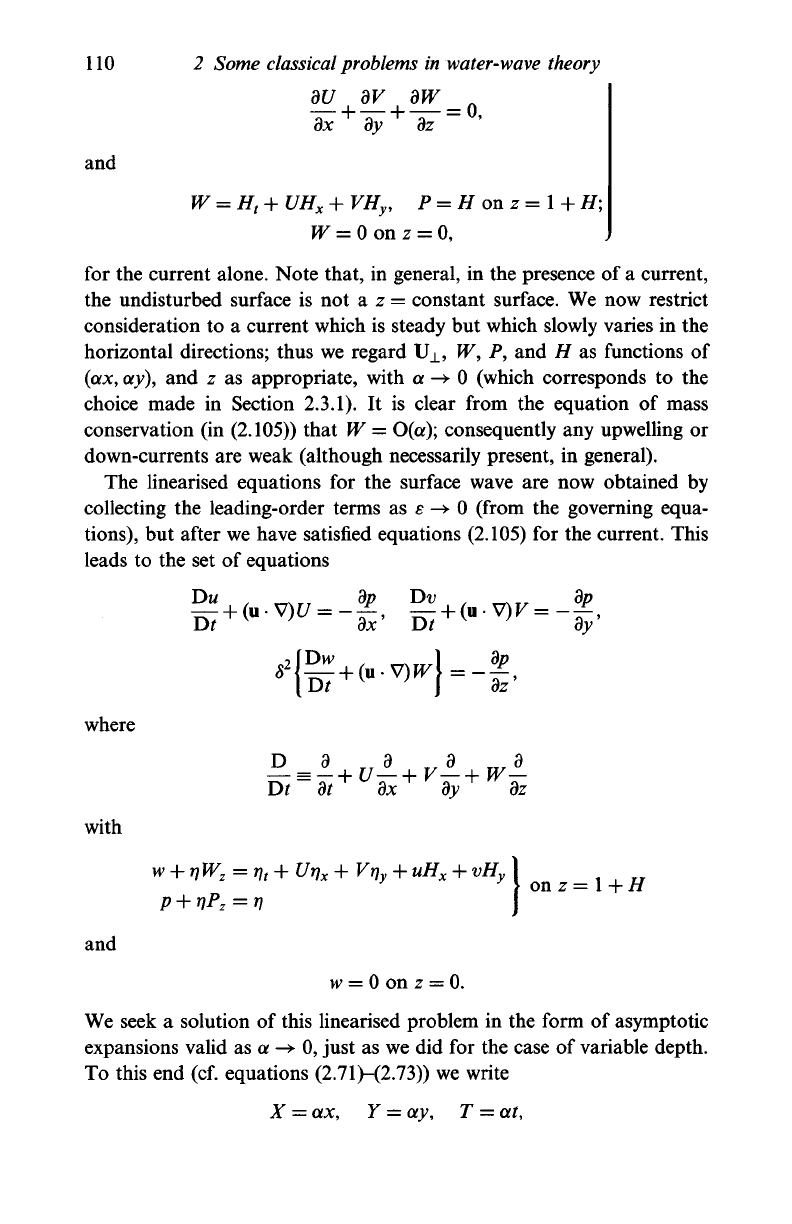
110 2 Some
classical problems
in
water-wave
theory
dU dV W
+ + 0
and
W = H
t
+
UH
X
+ VH
y
, P = H on z =
1
+ H;
W = 0 onz = 0,
for the current alone. Note that, in general, in the presence of a current,
the undisturbed surface is not a z = constant surface. We now restrict
consideration to a current which is steady but which slowly varies in the
horizontal directions; thus we regard U
±
, W, P, and H as functions of
(ax, ay), and z as appropriate, with a -> 0 (which corresponds to the
choice made in Section 2.3.1). It is clear from the equation of mass
conservation (in (2.105)) that W = O(a); consequently any upwelling or
down-currents are weak (although necessarily present, in general).
The linearised equations for the surface wave are now obtained by
collecting the leading-order terms as 6 -> 0 (from the governing equa-
tions),
but after we have satisfied equations (2.105) for the current. This
leads to the set of equations
DM
Dv
D7
dp
V
+ (u-
where
with
w + r)W
z
•=
rj
t
+ Ur\
x
+
Vr]
y
+ uH
x
+ vH
y
onz=l+H
and
w
—
0 on z = 0.
We seek a solution of this linearised problem in the form of asymptotic
expansions valid as a -> 0, just as we did for the case of variable depth.
To this end (cf. equations (2.71)-(2.73)) we write
X = ax, Y = ay, T = at,
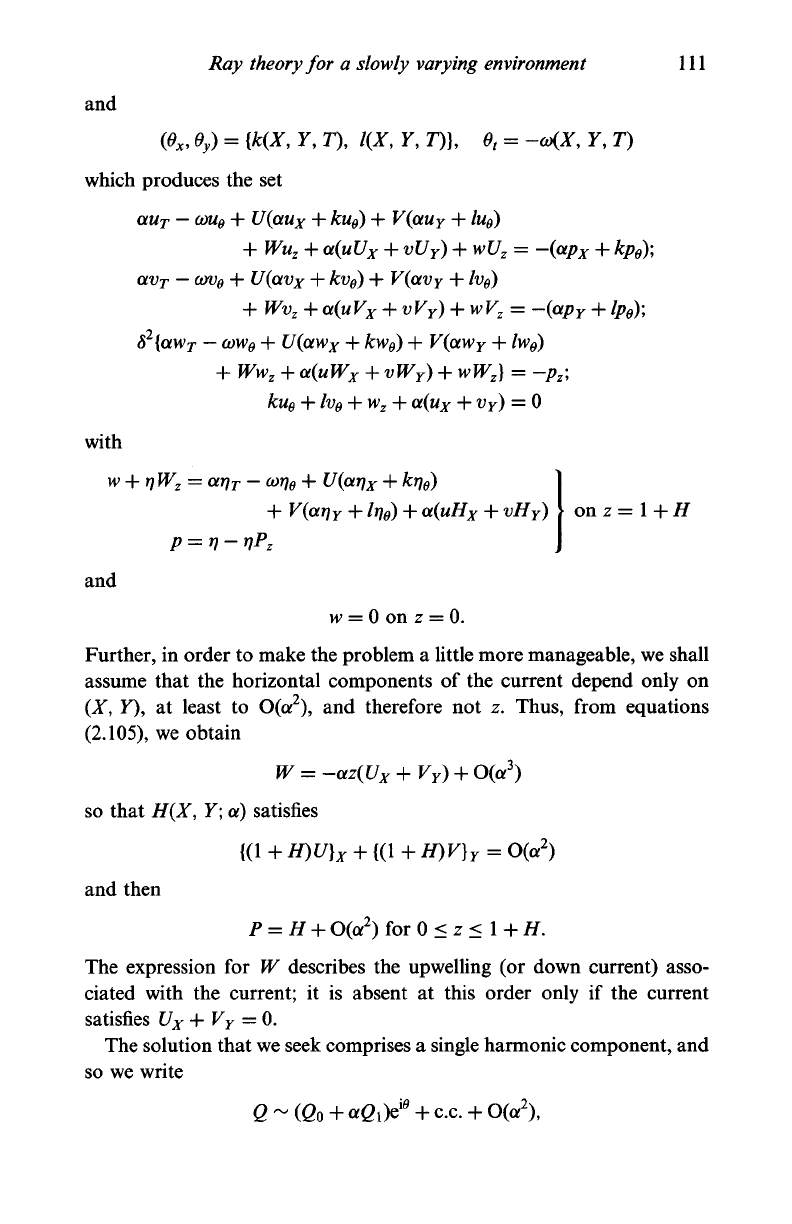
Ray theory for a slowly varying environment 111
and
(Ox,
Oy)
= W*. Y, T), l(X, Y, T)},
O
t
=
-co(X,
Y, T)
which produces the set
au
T
—
COUQ
+ U(au
x
+ ku
e
) + V(au
Y
+ lu
e
)
+
W^M
Z
H-
a(uU
x
+ vC/
r
) + wt/
z
= —(ap
x
+
^/?6>);
+ Wv
z
+
ot(uV
x
H-
^^y) + wF
z
= —(apy +
^P6>)»
5
2
{aw
r
— ce^Wgi
+ t/(aw
z
+
fcwg,)
+ V(aw
Y
+
/H^)
+ PFw
z
+
ot(uW
x
+ vW
Y
) + wW
z
) = —p
z
\
ku
B
+ fog + w
z
+ a(w^ + ^r)
=
0
with
w + t)W
z
= arj
T
-
corj
e
+ t/(a^ + kr)
e
)
+ V(arj
Y
+ /r/g) +
a(uH
x
+ v^r) on z =
1
+ H
p = rj-rjP
z
and
w
= 0 on z = 0.
Further, in order to make the problem a little more manageable, we shall
assume that the horizontal components of the current depend only on
(X, Y), at least to O(a
2
), and therefore not z. Thus, from equations
(2.105),
we obtain
so that H{X, Y\ a) satisfies
{(1 + H)U}
X
+
{(1
+ H)V}
Y
= O(a
2
)
and then
P = H + O(a
2
) for 0 < z <
1
+ H.
The expression for W describes the upwelling (or down current) asso-
ciated with the current; it is absent at this order only if the current
satisfies U
x
+ V
Y
= 0.
The solution that we seek comprises a single harmonic component, and
so we write
Q ~ (Go + <*ei)e
ie
+ ex. + O(a
2
),
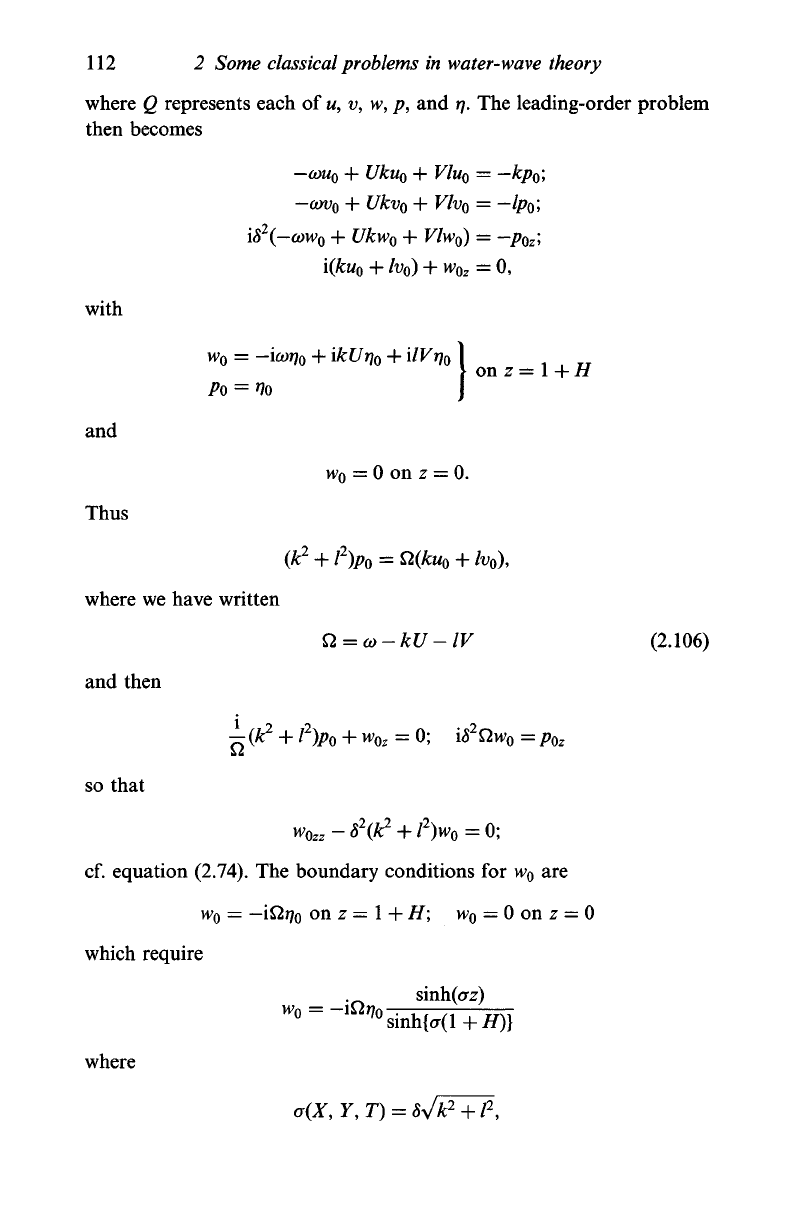
112 2 Some classical problems in water-wave theory
where Q represents each of u, v,
w
9
p, and
rj.
The leading-order problem
then becomes
-cou
0
4- Uku
0
+ Vlu
0
= -kp
0
;
-cov
0
+ Ukv
0
4- Kfo
0
=
—Ipol
i8
2
(-cow
0
+ C/fcw
0
+ Vlw
0
) = -p
Oz
;
i(ku
0
+ Iv
0
) + w
Oz
= 0,
with
w
o
= -ia)ri
o
+ \kUri
o
+ilVri
o
\
\ on z = I + H
Po
=
Vo
J
and
w
0
= 0 on z = 0.
Thus
where we have written
Q =
o)-kU-lV
(2.106)
and then
^ + w
0
, = 0; i<5
2
£2H>
0
= p
Oz
so that
cf. equation (2.74). The boundary conditions for w
0
are
w
0
= — iQrj
0
on z = 1 + H\ w
0
= 0 on z = 0
which require
sinh(orz)
where
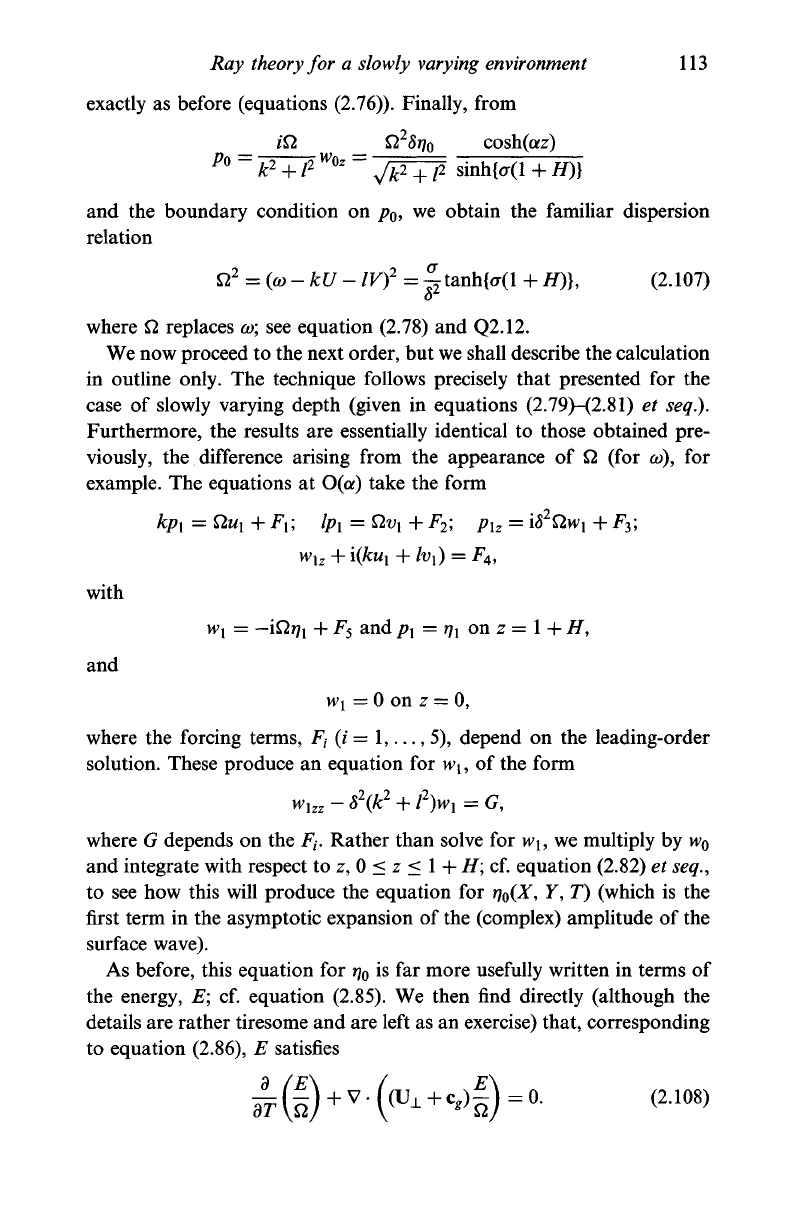
Ray theory for a slowly varying environment 113
exactly as before (equations (2.76)). Finally, from
!
Q
2
8rj
0
cosh(az)
Po =
sinh{or(l
and the boundary condition on p
0
, we obtain the familiar dispersion
relation
Q
2
=
(co
- kU - IV)
2
= ^tanh{<r(l +
77)},
(2.107)
where Q replaces
co;
see equation (2.78) and Q2.12.
We now proceed to the next order, but we shall describe the calculation
in outline only. The technique follows precisely that presented for the
case of slowly varying depth (given in equations (2.79)-(2.81) et
seq.).
Furthermore, the results are essentially identical to those obtained pre-
viously, the difference arising from the appearance of Q (for co), for
example. The equations at O(a) take the form
kp
x
= Qui + F
x
; lp
x
= Qv
{
+ F
2
; p
iz
= i
w
with
w
x
= — itlrji + F
5
and p
x
=
rji
on z =
1
+ 77,
and
w
x
= 0 on z = 0,
where the forcing terms, F
t
(i
—
1,..., 5), depend on the leading-order
solution. These produce an equation for w
1?
of the form
w
lzz
- h\k
2
+ /Vi = G,
where G depends on the F
t
. Rather than solve for w
1?
we multiply by w
0
and integrate with respect to z, 0 < z <
1
+
77;
cf. equation (2.82) et seq.,
to see how this will produce the equation for
rj
o
(X,
Y, T) (which is the
first term in the asymptotic expansion of the (complex) amplitude of the
surface wave).
As before, this equation for rj
0
is far more usefully written in terms of
the energy, E; cf. equation (2.85). We then find directly (although the
details are rather tiresome and are left as an exercise) that, corresponding
to equation (2.86), E satisfies
(|)0. (2.108,
